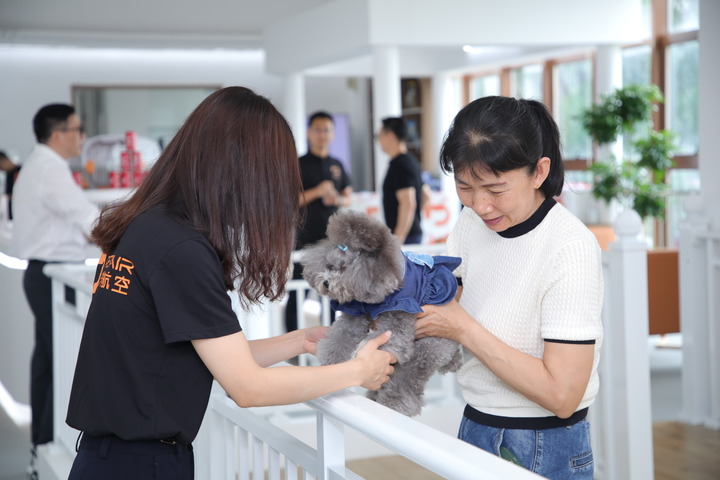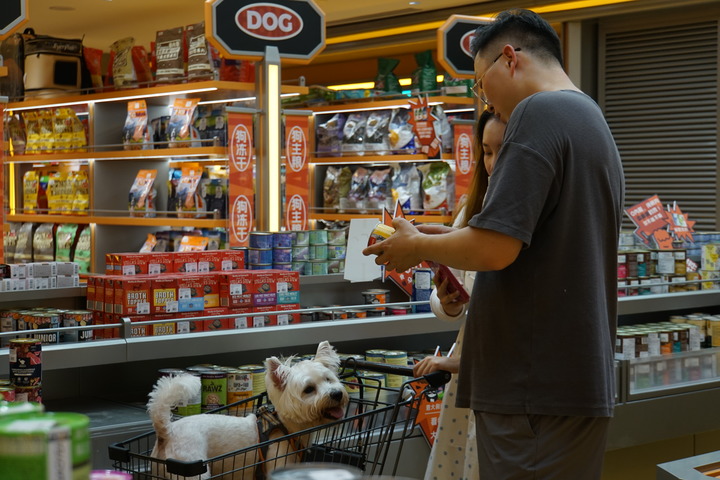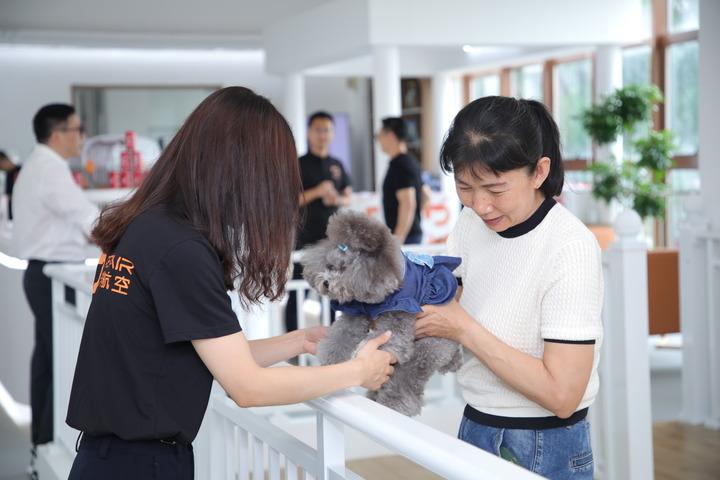
A dog is taken care of at the pet waiting lounge of Shenzhen Bao'an International Airport in Shenzhen, south China's Guangdong Province, May 8, 2024. (Xinhua)
BEIJING, Feb. 20 (Xinhua) -- Right before this Chinese Spring Festival, Mr. Liu, a native of Shanghai working in Guangzhou, returned home by plane, with his pet dog "Dafenqi" by his side during the two-and-a-half-hour flight.
"I paid 1,000 yuan extra to book a special seat for my pet. It feels great to fly home with my buddy!" Liu said with a smile.
Liu's "Dafenqi," a French bulldog, has been raised up by Mr. Liu since it was a puppy. He carefully selects premium food brands, customized snacks and toys, and takes it to pet shops for regular baths and pet grooming from time to time. For this home-returning trip, he booked the "pet in cabin" service recently launched by China Southern Airlines.
Liu's story mirrors the heating-up pet market and the booming pet economy in China over the past several years.
The market sees increasing needs for pets, experts say, giving such examples as more and more elderly people living alone or young people enjoy the little cuties for their company.
A consumption research report on China's pet industry shows that pets owned by people living in urban areas reached approximately 120 million in 2024, with fine care becoming a mainstream way.

Pet owners shop with their pet at Marsmart pet store in THE BOX Youth Energy Center in Chaoyang District of Beijing, capital of China, Aug. 16, 2023. (Xinhua/Zhang Zhaoqing)
"Taotao is really overweight so I bought it a treadmill and a heart rate monitor. I also bought cold compress to cool down its paws after exercise." 26-year-old Gao Boxin may grudge a sport watch for himself, but never skimps on spending money for his Corgi Taotao.
23-year-old Shen Jing spends around 1,500 yuan on her Golden Retriever every month, mostly on dog food, snacks and toys, in addition to some medical and healthcare expenses.
Industry observers note that the pet-related industry has seen rapid development in China, evolving into various segments such as food, clothing, travel, beauty, training, education, fitness and medical care. Pet-related enterprises are making innovative attempts to develop more consumption scenarios based upon functionalities, emotional satisfaction and social needs, advancing the complete and mature development of the pet economy.
In the workshop of Jiangsu Weihong Pet Products Co., Ltd., workers are busy baking and packaging batches of dog chews. The pet snack market has been growing quickly, Hu Zimeng, the company's general manager said.
The prices of pet grooming, beauty and boarding services all went up during the Spring Festival, according to a staff of a pet boarding shop in Huangpu District, Shanghai. "The price of pet boarding in our store rose from 100/day to 150/day, with almost no vacancy," said the staff.
As for "outfit", an online store selling original pet clothing named "Chunfeng Daxiaoqiao" has already designed and developed more than 40 kinds of pet clothing with distinctive styles from the traditional-Chinese-costume like suites to the "Frozen" style cloak, as well as various accessories like flower hairpins and rosemary fans. Other cat products are also available.
Experts note that the pet industrial chain roughly contains such three segments as pet breeding and trading, pet food, toys and clothing, as well as the service-dominated pet grooming, boarding, photography, medical care, insurance, among others.
Among them, the downstream services highlight the emotional needs of pet owners, giving rise to a number of "human-like" services that show stronger growing momentum.
In May 2024, China's first pet waiting hall was officially launched at Shenzhen Bao'an International Airport, together with innovative one-stop pet travel services. The waiting hall is equipped with a comprehensive monitoring system including temperature, humidity, air quality and other indicators, plus an entertainment area dedicated for pets, and each pet has its own independent waiting space. "This market is worth exploring," noted a departmental head of the airport.
An earlier research report on China's pet industry for 2023-2024 shows that the market scale of pet consumption in urban areas totaled 279.3 billion yuan, with the figure predicted to reach 361.3 billion yuan in 2026. Data from Qichacha, a leading platform offering company information inquiry services, reveals a steady increasing number of pet-related enterprises over the past decade. As of January 22, 2025, there were 4.246 million pet-related enterprises in China, with nearly 80 percent established in the past three years.
Welcoming the broad prospect of the pet economy, local authorities are weighing on support to cultivate the development of local pet-related industry.
Luohu District of Shenzhen, for instance, announced at the end of 2024 its plan to build the city's first pet economy industrial park covering approximately 75,000 square meters, with business including R&D, design, intelligent manufacturing and cross-border e-commerce of pet food and supplies.
Fengxian District of Shanghai formulated its development plan on pet economy while Ganzhou of Jiangxi Province included the pet health industry into the city's key industrial chains.
"China's pet consumption market scale is about 300 billion yuan at the moment, and it will surely top one trillion yuan in the future," envisaged by Song Weiqiang, the secretary-general of Shenzhen Pet Industry Association.
(Edited by Niu Huizhe with Xinhua Silk Road, niuhuizhe@xinhua.org)




 A single purchase
A single purchase









